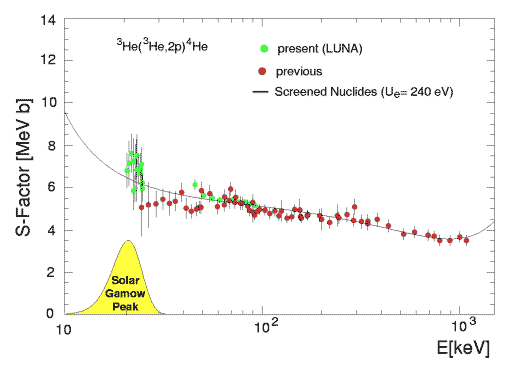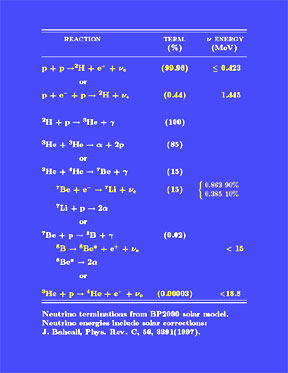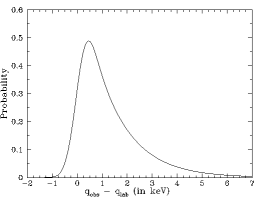
This figure
is Fig. 2 from the RMP paper by Adelberger et al. (1998)
and is adapted from Fig. 9 of Junker et al. (1998),
a recent paper by the LUNA Collaboration. The measured
cross-section factor S(E) for the 3He
(3He, 2p)4He reaction is
shown and a fit with a screening potential Ue
is illustrated. The
Gamow peak at the solar central temperature is shown in arbitrary units.
The data shown here correspond to a bare nucleus value at zero energy
of S(0) = 5.4 MeV b and a value at the
Gamow peak of S(Gamow Peak) = 5.3 MeV b.
Nuclear fusion reactions in the sun

The figure shows the principal reactions in the pp fusion chain in the
sun. The BP2000 solar model was used to calculate the fraction of the
terminations of the chain in which a given reaction participates. The
neutrino energies contain small corrections due to thermal phenomena
in the Sun.
Postscript
file pdf file
 The luminosity constraint on solar neutrino
fluxes
The luminosity constraint on solar neutrino
fluxes
Author(s): John N. Bahcall
Journal: Phys. Rev. C., 65 (January 2002),
025801, hep-ph/0108148.
Abstract:
A specific linear combination of the total solar neutrino fluxes must
equal the measured solar photon luminosity if nuclear fusion reactions
among light elements are responsible for solar energy generation.
This luminosity constraint, previously used in a limited form in
testing the no neutrino oscillation hypothesis, is derived in a
generality that includes all of the relevant solar neutrino fluxes and
which is suitable for analyzing the results of many different solar neutrino
experiments. With or without allowing for neutrino oscillations, the
generalized luminosity constraint can be used in future analyses of
solar neutrino data. Accurate numerical values for
the linear coefficients are provided.
postscript file
pdf file
 Solar Fusion Cross Sections
Solar Fusion Cross Sections
Authors: E. C. Adelberger, S. M. Austin, J. N. Bahcall,
A. B. Balantekin, G. Bogaert, L. S. Brown, L. Buchmann, F. E. Cecil,
A. E. Champagne, L. de Braeckeleer, C. A. Duba, S. R. Elliott,
S. J. Freedman, M. Gai, G. Goldring, C. R. Gould, A. Gruzinov,
W. C. Haxton, K. M. Heeger, E. Henley, C. W. Johnson, M. Kamionkowski,
R. W. Kavanagh, S. E. Koonin, K. Kubodera, K. Langanke,
T. Motobayashi, V. Pandharipande, P. Parker, R. G. H. Robertson,
C. Rolfs, R. F. Sawyer, N. Shaviv, T. D. Shoppa, K. A. Snover,
E. Swanson, R. E. Tribble, S. Turck-Chieze, and J. F. Wilkerson
Journal:Reviews of Modern Physics, 70,
1265-1292 (October 1998), astro-ph/9805121.
Abstract:
We review and analyze the available information for
nuclear fusion cross sections that are most important for solar
energy generation and solar neutrino production. We provide best
values for the low-energy cross-section factors and, wherever
possible, estimates of the uncertainties. We also describe the most
important experiments and calculations that are required in order to
improve our knowledge of solar fusion rates.
The cross sections and uncertainties quoted in this paper have been
used in the article ``How Uncertain Are Solar Neutrino Predictions?''
by J.N. Bahcall, S. Basu, and M. H. Pinsonneault, Phys. Lett. B,
433, 1-8 (August 1998), astro-ph 9805135, to determine the best-estimates and
uncertainties in solar neutrino fluxes and sound speeds.
pdf file
 The Salpeter Plasma Correction for Solar
Fusion Reactions
The Salpeter Plasma Correction for Solar
Fusion Reactions
Authors: John N. Bahcall, Lowell S. Brown, Andrei
Gruzinov, and R. F. Sawyer
Journal: A&A, 383, 291-295 (2002),
astro-ph/0010055.
Abstract:
We review five different derivations that demonstrate that the
Salpeter formula for the plasma corrections to fusion rates is valid
at the center of the sun with insignificant errors (~ percent).
We point out errors in several recent papers that have obtained a
variety of answers, some even with the wrong sign or the wrong
functional dependence.
postscript
file
pdf
file
 Screening in
Thermonuclear Reaction Rates in the Sun
Screening in
Thermonuclear Reaction Rates in the Sun
Authors:Andrei V. Gruzinov and John N. Bahcall
Journal:The Astrophysical Journal, 504,
996-1001 (September 10, 1998), astro-ph/9801028.
Abstract:
We evaluate the effect of electrostatic screening by ions
and electrons
on low-Z thermonuclear reactions in the sun.
We use a mean field formalism and calculate
the electron density of the screening cloud
using the appropriate density matrix equation
of quantum statistical mechanics.
Because of well understood physical effects that are
included for the first time in our treatment,
the calculated enhancement of reaction rates
does not agree with the frequently used interpolation
formulae. Our result does agree, within small uncertainties, with
Salpeter's weak screening formula. If weak screening is used
instead of the commonly employed screening prescription of
Graboske et al., the predicted 8B neutrino flux is increased
by 7% and the predicted chlorine rate is increased by 0.4 SNU.
postscript
file
pdf
file
 The Proton-Proton Reaction,
Solar Neutrinos, and a Relativistic Field Theoretic Model of the
Deuteron
The Proton-Proton Reaction,
Solar Neutrinos, and a Relativistic Field Theoretic Model of the
Deuteron
Authors: J. N. Bahcall and Marc Kamionkowski
Journal:Nuclear Physics A, 625, No. 4, 893-895
(November 10, 1997); astro-ph/9707320.
Abstract:
In a series of recent papers, Ivanov et al. and Oberhummer et al. have
calculated the rate for the p + p
 d +
e+ +
d +
e+ +  e
reaction with a zero-range four-fermion effective interaction
and find a result 2.9 times higher than the
standard value calculated from non-relativistic potential theory.
Their procedure is shown to give a wrong answer because their assumed
interaction disagrees with low-energy pp
scattering data.
e
reaction with a zero-range four-fermion effective interaction
and find a result 2.9 times higher than the
standard value calculated from non-relativistic potential theory.
Their procedure is shown to give a wrong answer because their assumed
interaction disagrees with low-energy pp
scattering data.
pdf file
 The 7Be
Electron Capture Rate in the Sun
The 7Be
Electron Capture Rate in the Sun
Authors: Andrei V. Gruzinov and John N. Bahcall
Journal: The Astrophysical
Journal, 490, 437-441 (November 20, 1997); astro-ph/9702065.
Abstract:
For solar conditions, we numerically integrate the density matrix equation for a
thermal electron in the field of a 7Be ion and other plasma ions and
smeared-out electrons. Our results are in agreement with previous calculations
that are based on a different physical picture, a picture which postulates the
existence of distinct continuum and
bound state orbits for electrons. The density matrix calculation of the electron
capture rate is independent of the nature of electron states in the solar
plasma. To within a 1% accuracy, the effects of screening can
be described at high temperatures by a Salpeter-like factor of
exp (-Ze2/kTRD), which can
be derived from the density matrix equation. The
theoretical uncertainty in the electron capture rate
is about ± 2%.
postscript
file pdf
file
 Electron-Screening
Correction for the Proton-Proton Reaction
Electron-Screening
Correction for the Proton-Proton Reaction
Authors: John N. Bahcall, Xuelei Chen, and
Marc Kamionkowski
Journal: Physical Review C (Brief Reports), 57,
2756-2759 (May 1998); astro-ph/9612209.
Abstract:
We test the Salpeter formalism for calculating electron
screening of nuclear fusion reactions by solving numerically the
relevant Schrodinger equation for the fundamental proton-proton
reaction. We evaluate exactly the square of the overlap
integral of the two-proton wave function and the deuteron wave
function and compare with the usual analytic approximation. The
usual WKB solution agrees with the numerical solution to
O(10-4).
pdf
file
 Temperature
Dependence of Solar
Neutrino Fluxes
Temperature
Dependence of Solar
Neutrino Fluxes
Authors: John N. Bahcall and Andrew Ulmer
Journal: Physical Review D, 53, 4202-4225
(April 15, 1996); astro-ph/9602012.
Abstract: Using a one-zone model of the
Sun, we derive expressions for the temperature dependence of the solar
neutrino fluxes. The exponents of the scaling laws agree to within
20 percent or better with the exponents extracted from detailed solar
models.
pdf file
 Central Temperature of the Sun Can be Measured via the
7Be Solar neutrino Line
Author(s): John N. Bahcall
Journal: Physical Review Letters, 71,
2369-2371 (October 11, 1993) hep-ph/9309292.
Central Temperature of the Sun Can be Measured via the
7Be Solar neutrino Line
Author(s): John N. Bahcall
Journal: Physical Review Letters, 71,
2369-2371 (October 11, 1993) hep-ph/9309292.

Abstract:
A precise test of the theory of stellar evolution can be
performed by measuring the difference in average
energy between the neutrino line produced by 7Be
electron capture in the solar interior and the
corresponding neutrino line produced in a terrestrial laboratory.
The high temperatures in the center of the
sun broaden the line asymmetrically, FWHM = 1.6 keV, and
cause an average energy shift of 1.3 keV. The
width of the 7Be neutrino line should be taken
into account in calculations of vacuum neutrino oscillations.
pdf
file
 Solar
Neutrinos: Where We Are, What We Need
Solar
Neutrinos: Where We Are, What We Need
Authors:John N. Bahcall
Journal: In Few-Body Problems in
Physics. Proceedings of the 15th
International Conference on Few-Body Problems in Physics, Groningen,
The Netherlands, 22-26 July 1997,
ed. J. C. S. Bacelar, A. E. L. Dieperink, and R. A. Malfliet
(Amsterdam: Elsevier Science Publishers), Nuclear Physics A,
631, 29c--41c (1998), nucl-th/9802050.
Abstract:
This talk was given at the 5th
International Conference on Few-Body Problems in Physics, Groningen, The
Netherlands.
I describe the five most important nuclear physics problems whose solution is
required for understanding the precise implications of solar neutrino
experiments, as well as compare the standard model predictions with solar
neutrino experiments and with helioseismological measurements.
pdf file
 Line Versus Continuum Solar Neutrinos
Line Versus Continuum Solar Neutrinos
Author(s): John N. Bahcall
Journal: Phys. Rev. D, 41, 2964-2966 (15 May 1990)
Abstract:
The rate of neutrino line emission is calculated for nuclei that are
usually assumed to produce only continuum neutrino emission. A
convenient formula is derived that gives for solar interior conditions
the ratio of the rates of neutrino line emission to continuum neutrino
emission. The only significant line emission from the solar interior
is expected from the pep and 7Be-electron capture reactions.
pdf file
 Do hep neutrinos affect the solar neutrino energy spectrum ?
Do hep neutrinos affect the solar neutrino energy spectrum ?
Author(s): John N. Bahcall, Plamen I. Krastev
Journal:Physics
Letters B, 436/3-4, 243-250 (September 24, 1998), hep-ph/9807525
Abstract:If the low energy cross section
for 3He + p 4He + e+ +
4He + e+ +  e,
the `hep'
reaction, is
e,
the `hep'
reaction, is  20 times larger than the best (but uncertain)
theoretical estimates, then
this reaction could significantly influence the electron energy
spectrum produced by solar neutrino interactions and measured
in the SuperKamiokande, SNO, and
ICARUS experiments.
We compare predicted energy spectra for different assumed hep
fluxes and different neutrino oscillation scenarios
with the observed SuperKamiokande spectrum. The spectra with enhanced
hep contributions provide better fits to the SuperKamiokande data.
20 times larger than the best (but uncertain)
theoretical estimates, then
this reaction could significantly influence the electron energy
spectrum produced by solar neutrino interactions and measured
in the SuperKamiokande, SNO, and
ICARUS experiments.
We compare predicted energy spectra for different assumed hep
fluxes and different neutrino oscillation scenarios
with the observed SuperKamiokande spectrum. The spectra with enhanced
hep contributions provide better fits to the SuperKamiokande data.
pdf file
 Back to John Bahcall (Recent Preprints and Reprints)
Back to John Bahcall (Recent Preprints and Reprints)
Address questions and comments about this server to webmaster@sns.ias.edu



 The luminosity constraint on solar neutrino
fluxes
The luminosity constraint on solar neutrino
fluxes
 Solar Fusion Cross Sections
Solar Fusion Cross Sections
 The Salpeter Plasma Correction for Solar
Fusion Reactions
The Salpeter Plasma Correction for Solar
Fusion Reactions
 Screening in
Thermonuclear Reaction Rates in the Sun
Screening in
Thermonuclear Reaction Rates in the Sun
 The Proton-Proton Reaction,
Solar Neutrinos, and a Relativistic Field Theoretic Model of the
Deuteron
The Proton-Proton Reaction,
Solar Neutrinos, and a Relativistic Field Theoretic Model of the
Deuteron
 d +
e+ +
d +
e+ +  e
reaction with a zero-range four-fermion effective interaction
and find a result 2.9 times higher than the
standard value calculated from non-relativistic potential theory.
Their procedure is shown to give a wrong answer because their assumed
interaction disagrees with low-energy pp
scattering data.
e
reaction with a zero-range four-fermion effective interaction
and find a result 2.9 times higher than the
standard value calculated from non-relativistic potential theory.
Their procedure is shown to give a wrong answer because their assumed
interaction disagrees with low-energy pp
scattering data.
 The 7Be
Electron Capture Rate in the Sun
The 7Be
Electron Capture Rate in the Sun
 Electron-Screening
Correction for the Proton-Proton Reaction
Electron-Screening
Correction for the Proton-Proton Reaction
 Temperature
Dependence of Solar
Neutrino Fluxes
Temperature
Dependence of Solar
Neutrino Fluxes
 Central Temperature of the Sun Can be Measured via the
7Be Solar neutrino Line
Central Temperature of the Sun Can be Measured via the
7Be Solar neutrino Line

 Solar
Neutrinos: Where We Are, What We Need
Solar
Neutrinos: Where We Are, What We Need
 Line Versus Continuum Solar Neutrinos
Line Versus Continuum Solar Neutrinos
 Do hep neutrinos affect the solar neutrino energy spectrum ?
Do hep neutrinos affect the solar neutrino energy spectrum ?
 4He + e+ +
4He + e+ +  e,
the `hep'
reaction, is
e,
the `hep'
reaction, is  20 times larger than the best (but uncertain)
theoretical estimates, then
this reaction could significantly influence the electron energy
spectrum produced by solar neutrino interactions and measured
in the SuperKamiokande, SNO, and
ICARUS experiments.
We compare predicted energy spectra for different assumed hep
fluxes and different neutrino oscillation scenarios
with the observed SuperKamiokande spectrum. The spectra with enhanced
hep contributions provide better fits to the SuperKamiokande data.
20 times larger than the best (but uncertain)
theoretical estimates, then
this reaction could significantly influence the electron energy
spectrum produced by solar neutrino interactions and measured
in the SuperKamiokande, SNO, and
ICARUS experiments.
We compare predicted energy spectra for different assumed hep
fluxes and different neutrino oscillation scenarios
with the observed SuperKamiokande spectrum. The spectra with enhanced
hep contributions provide better fits to the SuperKamiokande data.
 Back to John Bahcall (Recent Preprints and Reprints)
Back to John Bahcall (Recent Preprints and Reprints)